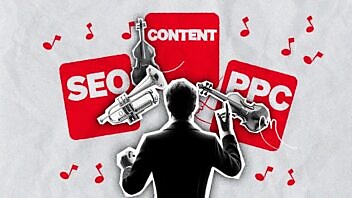This is one of a series of blogs about the changing B2B Go-To-Market landscape. You can check out the others in the series at the bottom of this piece.
Content as community: How content marketing is changing in the new B2B GTM
A few years ago, just after B2B content marketing morphed into, well, just B2B marketing, I got together with the senior team here. The agenda was that as content became mainstream, we needed to be more than just ‘the content marketing agency for B2B tech companies,’ That had served us well for many years but things were changing and we needed a new Galvanizing Idea.
We looked at a number of alternatives to answer ‘What does Velocity actually do?’ and ‘How should we align that with where the market is going?’ You’ll be glad to hear we quickly rejected ‘The B2B marketing agency for marketers who fucking hate marketing’* option.
*Actually, it’s not as stupid as it sounds. It was based on a belief — still strongly prevalent at Velocity — that most marketing treats marketers as morons and doesn’t recognize their agency or expertise. Hardly any of it has soul or craft. We set out to build a company that didn’t do those things.
One we liked at the time but ultimately spurned looks much, much stronger today. This was:
‘Velocity helps B2B tech companies build audiences.’
Our thinking was based around a definition of an audience as ‘a group (or community) of potential, highly relevant prospects who subscribe to receive your content and regularly return to get it,’ Back then, we were making content in short bursts to hit largely short-term goals — essentially, to feed the ravenous maw of the lead gen stack. (I say ‘back then’ but most B2B tech firms operate like this even now.)
All our clients’ processes and metrics were tied to delivering leads, not growing frequently returning audiences. Clients spent money in bursts, hoping to generate enough leads so they could get more money to do it all again (sound familiar?). Content was part of connected campaigns, sure, but the goal was to build an automated lead machine where ideally you could press a button and presto! content and paid media would alchemize to produce leads.
The concretization of that lead gen imperative was why we didn’t choose the audience-building positioning platform at that time.
What’s happening today, though, makes me think we were onto something back in 2017 when we rejected this positioning option in favor of our current story. Content marketing is now but one arrow in the B2B marketer’s quiver. But as I hope we’ve shown through this sequence of blogs about the new B2B GTM, prospects no longer value new content from vendors.
Attention is harder than ever to capture, mainly because, as Kieran Flanagan writes, in the last decade, “the number of marketing channels has stayed flat [while] the number of marketers nearly doubled.” At best the content itself is mediocre; at worst it’s total crap. (One of the most depressing aspects of the last 7–8 years is that content quality has been nakedly sacrificed on the altar of lead gen, as if content volume drives pipelines — no matter how rubbish the eBook, video, landing page or email.)
As it is, paid channels have strangled off organic reach and proven themselves to be one of the least efficient GTM channels (and efficiency only gets harder to find when you over rely on paid media — Google seems to be on an inexorable vector towards ever higher prices for every search term).
Today’s mantra is that to access prospects you have to pay (generally through the nose). Nearly everyone is seeing spiraling costs with plummeting pipeline performance. In lots of firms, moreover, an iron curtain is growing between sales and marketing where sales doesn’t generally value the content the marketing team produces (and is often running their own devolved content programs on their own platforms), and marketing is frustrated that sales doesn’t use the messages it has put so much time into manufacturing.
A new dawn?
The good news is that there are some early signs that B2B’s addiction to sugar rush leads is waning. We’re seeing early rumbles of what may prove to be a seismic stirring from traditional lead gen (or what Velocity calls ‘fire, and call what you hit the target’ marketing) towards a new community-focused GTM.
This community model delivers the right results using content arsenals that relevant prospects come back to again and again. In this new world, putting a form in front of mediocre content — and then having your telesales people call the poor deluded soul who filled it out 20 minutes later to ask if she wants to buy — is a non-starter.
The first glimmerings of change came from the intelligent Ehrenberg Bass Institute work showing only 5% of your market is ready to buy at any time and 95% are not. That’s surely a dagger in the heart of the simple-minded approach? The first AI-supported (admittedly early stage) platform to help marketers build and engage an owned audience — with best-practice media promotion and analytics — has appeared from Anthony Kennada’s company Audience Plus. And in a recent conversation with Jon Miller, the high priest of math-based inbound marketing, he mentioned that brands have to think more like the New York Times.
Learning from the NYT
The Times has probably been the most successful media property in the world, building subscription-based, digital-first content that’s always worth paying for. More than 10 million customers pay for premium experiences online, high-quality content and unexpected goodies like Wordle and all those great puzzles and podcasts.
The Times’s strategy can inform how B2B firms approach the next phase of content marketing (see their strategy document here). Their overarching goal is to be the best news destination in the world. They do that by producing entertaining, multi-format, authoritative stuff that subscribers can always trust.
Authority and trust married to a commitment to fun, engaging innovative formats feels like a content manifesto for B2B.
It is highly time- and resource-intensive. And the Times wants to do more than just write all the news that’s fit to print. They have oodles of material on culture, lifestyle, sports and much more. They’re curators at large with the task of helping their subscribers decide what to watch or read or attend or try or visit. And all these content products are connected so that subscribers can engage and get value out of all the Times offers.
Let’s contrast what the Times does to the typical B2B tech firm’s approach to content. The Times spends resources to build their audience; most B2B firms only spend to get leads. While acquisition costs are out of control for many companies, they spend like misers on content quality. This isn’t every B2B company — check out our interview in this series with Udi from Gong where he talks about what content quality means — but it’s a lot of them. Most content is tied to specific sales campaigns and could never be described as evergreen. Few companies use content to learn about their best prospects’ interests so they can target better when the prospect isn’t yet ready to buy.
Prospects’ confidence in content has dropped vertiginously mainly because that content is nearly always written for algorithms over humans.
B2B brands creating owned content spaces
Most brands are building their marketing strategy on rented land — paid leads, social, Google’s ever-diminishing organic SERP — but a few standouts are proving that owning audiences is an investment that makes marketing cheaper, engages prospects in a real way, and creates new demand rather than just throwing money at known demand.
Salesforce
Through its marketing, Salesforce has become so much more than a product to users. Their resources on how to run every function its products touch — from sales to marketing to customer service — are so comprehensive, their audiences literally never have to leave the site to answer to any question they have.
The eternally growing company has built a megabrand on the back of a broad definition of content: swaths of blogs, podcasts, conferences, certifications, webinars, original research, guides, career path help and more — much of it localized to different regions and roles.
Its Trailhead platform is maybe the most successful learning and development platform in SaaS, and the Trailblazers community that gathers around it is teeming with incredibly active user groups who meet online and in person. It’s the pinnacle of community-as-content.
Growfusely
The SaaS content marketing agency Growfusely punches above its weight with a series of well-produced guides about SaaS marketing. With titles like A Beginner’s Guide to Product-Led Content, the guides are both incredibly targeted and incredibly comprehensive. Informative visuals and original data up the education factor — helping them rank in Google and keep audiences invested.
Gong
Speaking of data, no one puts proprietary data to better use than Gong. The company is less than 10 years old but already has 4,000 customers and is worth $7.5 billion — in large part due to its incredible commitment to growing relationships with users. They seek to add value and build ‘memory links’ long before hitting up an audience for a sales interaction.
Gong Labs is an especially interesting idea. It publishes content based on the massive data set Gong mines from tens of millions of sales calls in the platform they sell.
And their audience of sales leaders eats it up. Why not, when they can read articles that give them extraordinary insight like, “When competitors are discussed early in the sales cycle, it’s a positive signal that the buyer has real intent to buy. … In fact, an early competitive mention increases the odds of winning an enterprise deal by 32% over not discussing the competition.”
Brand matters again
The experts now tell us best practice is changing towards thinking about a new balance between brand and lead gen. In our recent conversation, Jon Miller said prospects are so tired of traditional inbound tactics that B2B marketers today should spend 40% of their budgets on brand. (BTW, we agree: check out our new, sort-of B2B marketing manifesto here.)
Even Google, despite making mountains of money from the sugar-rush mindset, seems to agree. Recently an anonymous ex-Google employee leaked a ton of internal Google documents to former SEO rockstar Rand Fishkin about the attributes the search giant may use to analyze and rank websites. After concluding that the material was legit, Fishkin said if there was one universal piece of advice he had for marketers seeking to improve their organic search rankings and traffic, it would be: “Build a notable, popular, well-recognized brand in your space, outside of Google search.”
Rand’s compadre Mike King from iPullRank agrees: “Make great content and promote it well; if you really want to win in Google long term, make things that continue to deserve to rank”.
So what does this all mean for B2B content marketing?
When we first started Velocity, we identified the profound shift from renting marketing assets — like a direct marketing list, exhibition attendance, or TV and print advertising — towards owning them.
Joe Pulizzi, content marketing guru and founder of the Content Marketing Institute, agreed, saying, “Don’t build your house on rented land.”
The irony is that 15 years later, the obsession with paid advertising and social media is abso-fucking-lutely building on rented land.
Building an audience is the exact opposite of this. It’s creating a direct relationship with your prospects and customers. Of course we need advertising, but we also increasingly need a deeper, more direct route to market. That comes from earning the right to your own audience.
Incidentally, the aforementioned Rand Fishkin proved that with his Friday chalk talks all those years ago that built a highly receptive audience of SEO nerds and created SEOmoz. The average Whiteboard Friday post got more than 15,000 unique views. The highest got over 200,000.
Brands that try to build audiences enjoy major advantages: they get better ROI from marketing spend — marketing gets cheaper over time and prospect engagement is exponentially better; they address the 95%, not just the 5%; and they create content that builds brand as well as demand.
Sometimes at Velocity we talk blithely about ‘quality’ content without explaining what that means. It feels like quality comes from three Cs:
- Creative content means attracting relevant prospects who subscribe and come back because it serves their needs first rather than shilling your product. It stops you being a paid search lackey gaming Google not to bury your best pieces on p84.
(As an aside, most B2B content today is perfectly competent and professional — but it’s bland and boring, and much of it reads like an assembly manual for a bookcase. The best content says ‘I know what I’m talking about, I’m passionate about it and I know its importance to you dear prospect.’ Fun is a critical missing element too — before you can even ask yourself ‘How can I convince these people to do what I need them to do?’ you have to ask yourself ‘How can I get these people to stop what they’re doing and listen to me?’)
- Community means showing you understand the audience intimately, attracting the ones with shared perspectives and challenges, and showing personalized content rather than providing the same crappy eBook to everyone.
- Curation means being helpful to your audience before asking them to buy something. Pointing to useful content outside of your world garden and giving your two cents worth on what it means.
It feels like the future of content is about doubling down on creating an audience of relevant people who subscribe and come back. It’s done by serving their needs first (and last) and trying to earn repeat visits. That means being committed to learning about your best prospects’ interests. Only then will you be able to drive down the cost of acquisition, free yourself from the tyranny of paid search and solidify more predictable pipelines.
Audience building is a longer-term play but if you start today, you’ll see benefits in 3-4 months or so. You’ll earn more organic search traffic and you’ll attract the right prospects into nurture flows.
What are you waiting for?

Founder
Stan started out in university teaching before moving into military intelligence. By a circuitous route, he found himself heading up the UK’s biggest tech PR company (Brodeur) and flogging it to Omnicom.
Published in:
b2b-marketing
digital-marketing

Enjoyed this article?
Take part in the discussion




















Comments
There are no comments yet for this post. Why not be the first?